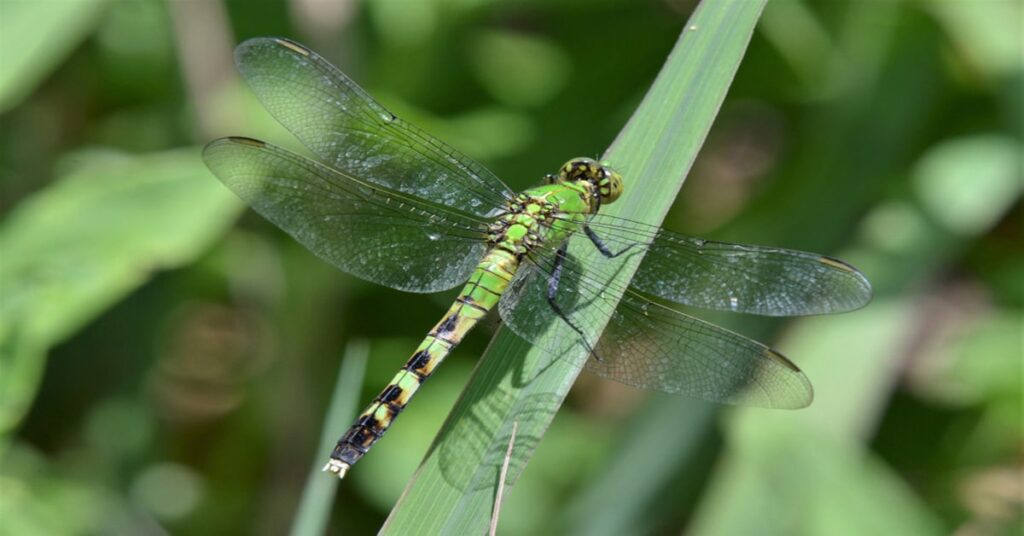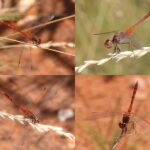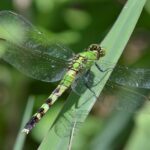The Common Green Darner (Anax junius) is a striking dragonfly species resembling a darning needle, belonging to the Aeshnidae family. One of the most widespread dragonflies in North America, its range extends southward to Panama. Like Monarch butterflies, these dragonflies are renowned for their migratory behavior, traveling from the northern United States to warmer climates such as Mexico and Texas. They are also found in Tahiti, the Caribbean, and parts of Asia, from Japan to China. In the United States, the Green Darner holds the distinction of being the official insect of Washington State.
Scientific Classification
Kingdom: Animalia
Phylum: Arthropoda
Class: Insecta
Order: Odonata
Suborder: Anisoptera
Family: Aeshnidae
Genus: Anax
Species: A. junius
Binomial Name: Anax junius
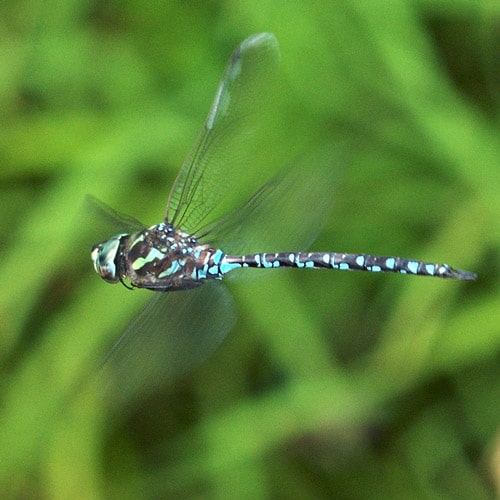
Morphology and Identification
As one of North America’s most prevalent dragonflies, the Common Green Darner is a large insect, reaching lengths of 6.8 to 8.4 cm, with a wingspan of approximately 9 to 11.4 cm. Its hind wings measure between 4.5 and 5.6 cm. This species is characterized by a vibrant green thorax and head, contrasting sharply with a striking blue abdomen. In females and immature individuals, the abdomen is typically pale green, brown, or reddish. All individuals, regardless of sex or age, display a distinctive dark stripe along the upper abdomen. Its elongated and narrow body, resembling a darning needle, inspired its common name.
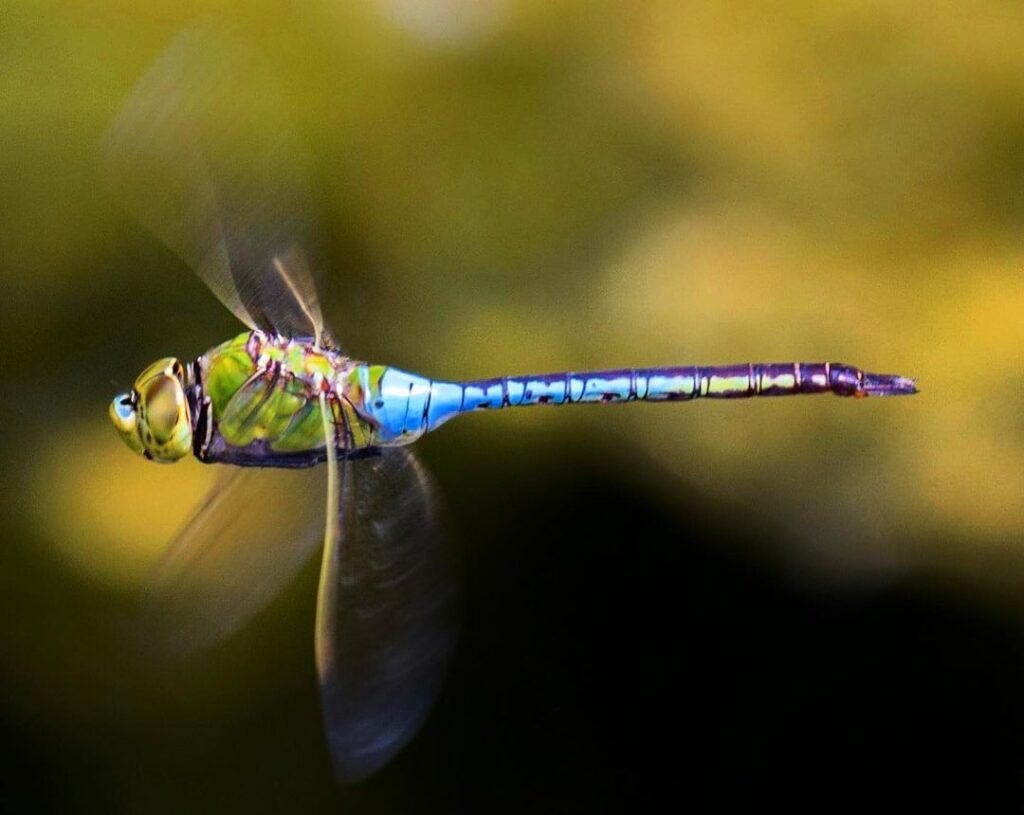
The face of the Green Darner is a yellowish-green shade, with large, dark green eyes positioned atop the head. A prominent “bull’s-eye” marking, consisting of a brown or black spot encircled by a yellow and blue ring, adorns its forehead. While their wings are initially transparent, they often acquire an amber tint with maturity, particularly in females. The legs are predominantly black or brown. During colder months, these dragonflies may adopt a darker purple or grayish hue, an adaptation that enhances their ability to absorb heat from the sun.
In its larval stage, the Green Darner is elongated and smooth, adorned with brown and green markings. The aquatic nymphs undergo multiple developmental stages over an extended period before molting into their adult form.
Breeding and Life Cycle
The Common Green Darner exhibits a unique breeding pattern, as it is among the few dragonfly species that migrate seasonally. While some individuals overwinter as larvae before maturing in spring, the majority migrate southward in autumn, often forming vast swarms. These migrating populations are believed to breed in the southern United States, Mexico, and the Caribbean, producing a new generation that subsequently migrates northward for summer reproduction. Offspring from northern summer breeding sites return south as immature dragonflies to continue the cycle.
Male Green Darners patrol bodies of water, defending their territory against intruders while seeking mates. Their reproductive process is distinctive among Odonates: males transfer sperm from primary genitalia to secondary genitalia located beneath the abdomen, which includes a specialized sperm reservoir and penis. Once a suitable female is located, the male clasps her head with his terminal appendages, while the female grasps his abdomen with her middle legs. They may remain airborne in this position for an extended period. After mating, the female deposits her eggs in aquatic vegetation, while the male stands guard to prevent rival males from interfering.
Diet and Predatory Behavior
Like other dragonfly species, the Common Green Darner is a formidable aerial predator, relying on its exceptional vision to detect prey and evade predators. Active during both daytime and dusk, they often form swarms over rivers, fields, and lakes where food is abundant. Their diet consists of various flying insects, including mosquitoes, butterflies, flies, moths, and even smaller dragonflies. The aquatic nymphs are equally predatory, consuming tadpoles, small fish, mosquito larvae, and other aquatic organisms. The nymphs capture prey using their specialized lower jaw, or ‘labium,’ which is equipped with hooks that secure their victims.

Distribution and Habitat
The Common Green Darner inhabits a vast range spanning North America, including Canada and Alaska. It is also found in Central and South America, encompassing Mexico, the Caribbean, Bermuda, the Bahamas, and various islands such as Cuba, Jamaica, and Puerto Rico. Populations have also been recorded in Hawaii, France, the United Kingdom, and northeastern Asia.
As a migratory species, the Green Darner occupies a variety of habitats throughout its journey. While it can be found far from water sources during migration, breeding occurs near still-water environments such as ponds, swamps, marshes, estuaries, and slow-moving streams.
Threats and Conservation
Currently, the Common Green Darner remains abundant and widely distributed, particularly in North America. However, like other dragonfly species, it faces potential risks from habitat destruction and pollution, particularly the degradation of wetlands.
Despite no immediate conservation concerns, future threats may necessitate international collaboration and conservation measures due to the species’ migratory nature. Preservation of wetland ecosystems will be crucial in ensuring the continued survival of this remarkable dragonfly.
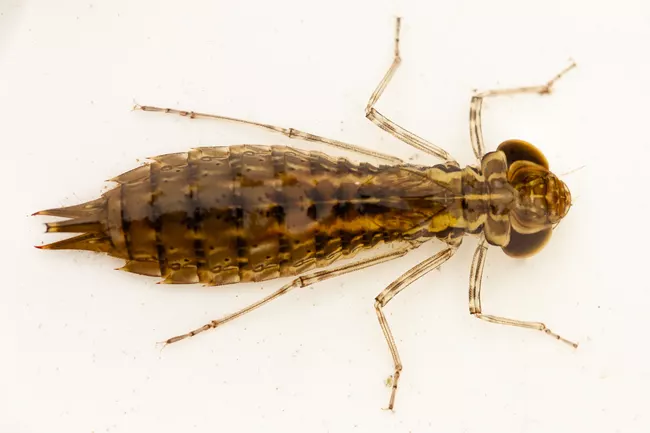
Fun Facts
- The name “darner” originates from its resemblance to a darning needle.
- This dragonfly’s compound eyes contain over 30,000 individual lenses (ommatidia), providing nearly 360-degree vision and the ability to perceive ultraviolet light.
- Dragonflies are among the oldest winged insects, with fossils dating back more than 300 million years, predating even the dinosaurs.
Where to Spot Them
The Common Green Darner can be observed in various wetland habitats, including ponds, lakes, and marshes. During migration, they may also be seen far from water, soaring over open landscapes in search of food and favorable climates.
Common Green Darner: A Master of the Skies
One of North America’s most widespread and recognizable dragonfly species, the common green darner (Anax junius), is also a remarkable long-distance migrant. Scientists are only beginning to unravel the complexities of its multigenerational migration. This species has been recorded covering an astonishing 122 kilometers in a single day, reaching speeds of up to 58 kilometers per hour during its seasonal journeys.
Appearance
Named for its resemblance to a darning needle, the common green darner boasts a robust thorax and an elongated, slender abdomen. This large insect measures between 6.8 and 8.4 centimeters in length—comparable in size to a hummingbird—and possesses an impressive wingspan ranging from 9 to 11.4 centimeters.
Its striking coloration includes a yellowish-green face, large, dark eyes, and a distinctive dark marking atop its head. Males exhibit a deep green thorax contrasted by a pale blue abdomen, while females and immature individuals display a more muted palette, with abdomens varying in shades of green, reddish-brown, or tan. A dark longitudinal stripe runs along the upper side of the abdomen in both sexes, further enhancing its distinctive appearance.
Habitat and Distribution
The common green darner is widely distributed across North America, ranging from Alaska and southern Canada through the United States. It is also found in Mexico, the Caribbean—including Cuba, the Cayman Islands, Jamaica, Puerto Rico, and Barbados—as well as the Hawaiian Islands.
This species thrives in a variety of freshwater habitats, including inland wetlands, ponds, lakes, slow-moving streams, shrublands, forests, and grasslands, where it plays a crucial role as both predator and prey in its ecosystem.
The Phenomenon of Migration
One of only 16 migratory dragonfly species in North America, the common green darner undertakes an extraordinary multigenerational migration akin to that of the monarch butterfly. The individuals that return to Canada each spring are the grandchildren of those that departed in the previous autumn.
The cycle begins in February when the first generation emerges in the southern United States, as far south as Mexico and the Caribbean. These dragonflies embark on a northward journey, reaching New England and Canada, where they breed, lay eggs, and eventually perish. Their offspring mature and migrate south between July and October, while some remain in the nymph stage through the winter, delaying their migration until the following year. The third generation, born in the south, resides there permanently, while their progeny are the ones that make the long return flight northward.
Despite its ecological significance, insect migration remains an underexplored field, with only a handful of researchers delving into its mechanics. At the University of Guelph, scientists have employed tracking devices affixed to dragonflies’ abdomens to measure flight paths, distances, and speeds. These studies have also examined the influence of precipitation and temperature on migratory patterns. Additionally, researchers have analyzed hydrogen isotopes in wing samples—chemical markers that vary along the continent’s north-south gradient—to infer the approximate birthplaces of individual dragonflies.

